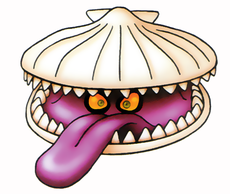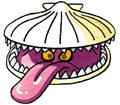Morphean mollusc
From Dragon Quest Wiki
| Dragon Quest monster | |
|---|---|
| Morphean mollusc | |
Art by Akira Toriyama | |
| Japanese | たまてがい |
| Romaji | tamate-gai |
| First appearance | Dragon Quest V |
| Old localization | Scallopa |
The Morphean mollusc is an aquatic monster that first appeared in Dragon Quest V.
Appearances
Dragon Quest V
Dragon Quest Monsters 2
| Frizz Resistance * | Sizz Resistance * | Fire Breath Resistance * | Bang Resistance * |
| Strong | Strong | Strong | Strong |
| Crack Resistance * | Ice Breath Resistance * | Woosh Resistance * | Rock/Army Resistance * |
| Weak | Weak | Strong | None |
| Water Resistance * | Zap Resistance * | Gigaslash Resistance | Magic Burst Resistance |
| Strong | Weak | Weak | None |
| Drain Magic Resistance * | Whack Resistance * | Kamikazee Resistance * | Poison Resistance * |
| None | Weak | None | Strong |
| Paralysis Resistance * | Fuddle Resistance * | Snooze Resistance * | Dazzle Resistance * |
| Strong | Weak | Strong | Weak |
| Fizzle Resistance | Ban Dance Resistance | Gobstopper Resistance | Stun Resistance * |
| None | Strong | Strong | None |
| Sap Resistance * | Decelerate Resistance * | Curse Resistance | |
| None | Strong | None | |
Related enemies
Gallery
Etymology
This monster's Japanese name, たまてがい tamategai is possibly a play on words of the 玉手箱 tamatebako from the famous Japanese fairy tale Urashima Tarō.
The "bako" (hako before "rendaku") in tamatebako means "box", while the "gai" (kai before rendaku) in "tamategai" means "clam". The "tamate" is two seperate words, with "tama" meaning jewel and "te" meaning hand, which would literally mean "tamate" translates to "Jewel Hand", but the words aren't agreed to impart any special meaning in this context, and might be merely phonetic.





